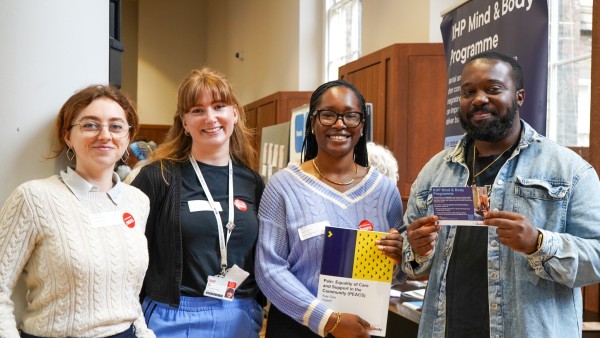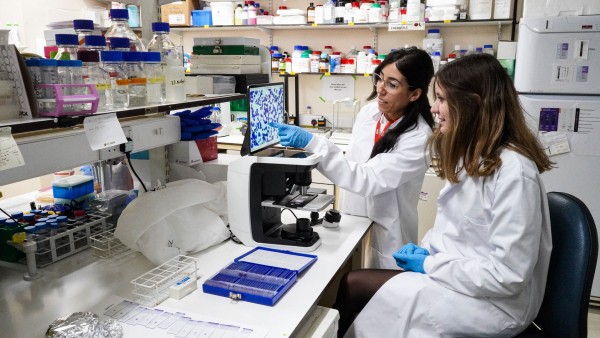19 October 2022
Consultant Spinal Physiotherapist Andrew McCarter [pictured] tackles commonly held beliefs including bad posture, lifting, a weak core, and the back’s vulnerability.
Does a bad posture cause back pain? Should I exercise if I have a bad back? Do I need to improve my core?
Although a common condition, people often have a lot of questions and nervousness when it comes to treating their back pain. But, according to Andrew McCarter, a Consultant Spinal Physiotherapist at King’s College Hospital NHS Foundation Trust (FT), this shouldn’t be the case.
In a blog for King’s Health Partners, he sets out six common myths and misconceptions around lower back pain.
‘A delicate structure that requires protection’
While back pain can be very painful and worrying, it is very common and rarely dangerous.
A total of 84% of people worldwide will experience back pain during their lifetime. It's equally common across all age groups. Mostly people recover reasonably quickly, and many recover without requiring treatment. Some people experience repeated episodes of back pain, but again these are rarely dangerous.
Yet we tend to think and manage back pain differently to other musculoskeletal issues such as knee pain or a sprained ankle. Historically the back has been considered a delicate structure that requires protection.
One of the issues is we tend to only hear negative things about back pain and the recovery from back pain, and there are a lot of myths and misconceptions out there. Therefore, when we do have back pain or sprain our backs we are already on the back foot. We are often more worried than if it was a sprained ankle, for example.
Yet we need to reframe this and manage the back like any other area of the body - by actively managing it. Not by waiting for it to improve before we get back to normal but instead having techniques to help it get better so that we can return to our important activities and prevent long term problems.
Myth number one: your back is vulnerable to damage
This is not the case. Another issue with the spine is an assumption that it is weak and needs to be protected. The spine is robust, adaptable, and has multiple muscles and ligaments to help it stay strong and help us function.
This belief that our backs are vulnerable is often reinforced and perpetuated by what we read and the ‘treatments’ and ‘cures’ that are offered. We often hear about joints being out of place, your pelvis being misaligned or your disc has slipped. No wonder these ideas often promote fear, and protective movement patterns, avoidance of activity, and disability.
From the outset I want to reassure people that this is not the case. Treatments are then offered to put these structures back into place. While many will experience short-term relief after these treatments, any benefit is due to changes in the nervous system and muscle relaxation, not due to realigning of discs and joints.
Myth number two: a weak core is to blame
This belief that your back is vulnerable and weak has also led to core exercises becoming very popular. Yet research has shown it is no more effective than other types of exercise for back pain.
The idea that we need to ‘hold in our core’ has become so popular with some people that it can sometimes lead to further problems – especially if they are holding in their core during normal everyday movements, positions and activities – as this increases muscle tension, overworks the muscles and puts more pressure on joints. Therefore core exercises can further increase stiffness which is often the cause of ongoing back pain in the first place.
It is no wonder then if you do have to reach for something quickly it often hurts more and might feel like you will’ break in half’ as I hear so often. This is not because you have damaged your back but because of muscle tension, however this can reinforce the belief that your back issue must be serious and you need to be even more careful.
So you continue to further adjust and modify your normal movement. You stop bending. You keep your core contracted when you move, hold your breath when bending/ lifting, start using a back support. You ask for a new chair at work or a standing desk, but all of this reduces our day-to-day movement and can maintain and increase muscle tension and increase fear.
When a child bends they don’t consciously think about the movement, they don’t hold their breath or tense their core. They just bend. The body is clever enough to work out what is required to bend and lift. We confuse the body when we force ourselves to move differently. This is often common and necessary initially after an injury but these habits need to then be reduced as we get better. It is often these new habits, these maladaptive or unnatural movements that cause persistent symptoms, and lead to ongoing pain, stiffness and fear, and increase the likelihood of reoccurrence as you have reduced your variability of movement.
Movement should be unconscious and that should be the target to aim for when you are trying to get over an episode of back pain.
The key is trying to move in a relaxed and ‘normal’ way when you have back pain. We need to vary our movement as much as possible and not limit it.
Myth number three: back pain is caused by bad posture
I am sure you have heard that back pain is caused by bad posture or slouching, or someone tells you the importance of standing or sitting upright. The right posture for one person is not necessarily the same for another person. Posture is somewhat genetic. Yet people are told of the importance of sitting up straight, not to slouch.
While slouching is often blamed, there is no scientific evidence to support this as a cause of back pain. In fact, recommending an upright rigid posture can increase muscle tension and does not allow muscles to relax which can potentially exacerbate symptoms.
In clinic I often see people with back pain, sitting bolt upright in their chair or moving in a robotic manner as they have read or been told that is what they should do or unfortunately what society has deemed we should do. When you ask them how it feels they often say not very comfortable but they assume it must be helping as it is such a commonly held belief.
In saying that, if sitting upright is comfortable when you have back pain then that’s fine. But if this feels uncomfortable then simply don’t do it.
Varying sitting posture throughout the day is probably better than trying to retain one optimal position. It is inactivity and static postures that can lead to discomfort, not that one posture is particularly bad or good.
The idea that we have to maintain an optimal position throughout the day will increase tension and stress, whether this is sitting slouched, cross legged or upright. Therefore, the aim should be to increase the variability of your movement and postures throughout the day
There is a saying that your best posture is your next posture!
Myth number four: lifting is bad for your back
Your back is designed to move and adapt to many activities, and it is designed for bending and lifting. However, it is important for your back to be conditioned to bend and lift. Essentially it needs to be trained for these activities. Just like if you start training for a marathon you need to start off small and gradually build up. What do you think would happen if your first training session was a 26-mile run?
So to be able to lift, you need to start with lighter things and allow your back to adapt and develop ways of doing this. You need to build up these activities. Don’t be worried about lifting or bending.
We as health care professionals often don’t help by telling people to be careful, keep your back straight, bend with your knees when lifting. We now know this is incorrect. We should bend and lift in as natural way as possible – this actually reduces the tension in your back. Also, if you don’t allow your back to bend and move throughout the day then it is likely to stiffen up, and we are much more likely to irritate it if we have to suddenly bend or move, for example.
Myth number five: scans will show the cause of my back pain
A lot of people think that a scan, for example an X-ray or MRI, will identify the cause of their back pain. However, the research shows that scans for low back pain are rarely helpful and do not normally show what is causing the problem. This is because scans do not show tight and stiff muscles and joints. Scans are only needed when a serious condition is suspected (such as cancer, broken bones, infection) or when surgery is being considered.
The big problem with having a scan is that it will almost always show something. But the relevance of that something is the problem. This is because when a scan is reported, the radiologist has to report everything they see. For example, if I had a scan of my face it would be reported as having wrinkles, grey hair etc. This does not mean my skin is damaged or needs treatment – it just means that it is showing normally age-related changes and essentially that I am not 18 anymore - however all changes would still have to be reported.
We know with the back, the changes seen on a scan often do not correlate with a patient’s actual symptoms. There have been many studies done where we MRI people who have never had back pain and we have found at the age of 60, 88% adults will have disc degeneration and 70% will show disc bulges. We know 30% of 20 year olds have disc bulges. Even 22% of asymptomatic children can show disc degeneration on MRI.
As you can imagine due to this, imaging can often make things more confusing and complicated for patients. A good thorough assessment is often more useful to diagnose a patient who has back pain.
Also, scan reports can increase people’s concerns, as often the wording is full of worrying terms but it’s important to remember many of these things are common in people without pain as we have just seen.
Therefore, if you do have a scan it is essential to discuss the results with the specialist who referred you for the scan so they can interpret the findings in the context of your symptoms.
Myth number six: exercise will cause further problems when I have back pain
The most important thing to remember is exercise is not bad for low back pain - so people should not feel they have to avoid exercise.
Exercise helps improve general health, mood, anxiety, depression, and stress.
In the early stages of back pain it’s important to try and find the balance between not resting completely, and letting the lower back pain settle. You might need to reduce or alter certain painful activities for a few days, and then gradually build them up again. However, it is important that people do not wait for all the pain to be go, before they start moving and exercising.
During an episode of low back pain or when getting back to exercise after an episode, it is common to feel uncomfortable doing exercise, but this is not doing damage, and people should be confident to continue exercising.
All forms of exercise have potential benefits, and no one form of exercise has been found to be better than another. Unfortunately there is no magical, cure-all exercise. The type of exercise is not as important as actually getting it done.
I used to be very prescriptive about what exercises to do, but we now know that all exercise is useful so it is more about finding things you enjoy and more importantly that you will stick to. There is no point in doing Pilates or going swimming if you don’t enjoy it as you might do it for a short while but it is likely it won’t be maintained. So find something you enjoy as this will help your back but also your mood and help to relax you. If you do not like one activity, they try something else. Be flexible.
Conclusion
Back pain is very common but rarely serious. The key to getting back to normal is trying to remain as active as you can and move as normally as you can. If you have developed habits to try and help then try to undo those as soon as you can, as these are often the reason things don’t settle and cause ongoing flare ups.
Although this blog is about localised lower back pain, there are other causes of back pain that may require specific assessment and treatment.
So, if your back pain is not settling or if you are worried, then I recommend you see a health care professional at your GP surgery or self-refer to physiotherapy if you have this option in your local area.
They may refer you on for further assessment to a Musculoskeletal Clinical Assessment and Triage Service to see a specialist practitioner. They will be able to provide expert assessment of your back and discuss with you whether any further investigations or referrals to other services are required. Typically your GP is unable to do this directly.
If you would like further information about managing your back pain I recommend going to the following websites:
https://
https://
Andrew McCarter, on Twitter @_AndrewMcCarter, is a Consultant Spinal Physiotherapist at King’s College Hospital NHS FT and MSK lead, SE London and Kent Spinal Network. He works in the spinal clinics with the neurosurgeons and in the musculoskeletal department.
Liked this article? Explore how King's Health Partners Neurosciences brings together world-class research, education and clinical practice across the partnership to drive improved holistic outcomes for patients living with a wide range of neurological conditions.





